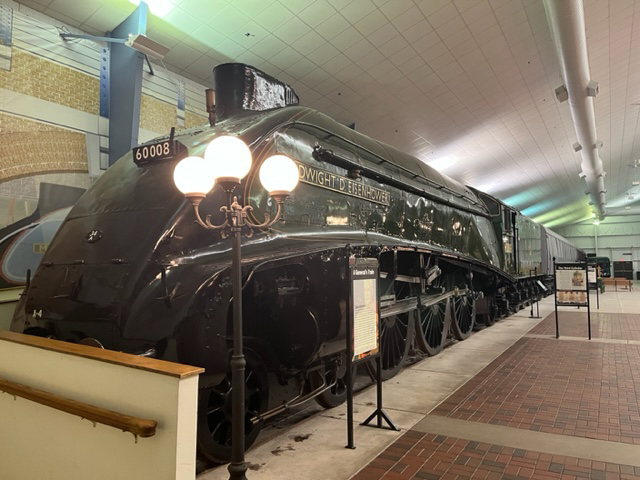
By Annika Morschauser
Contributing Writer
GREEN BAY – The National Railroad Museum is a nonprofit organization that began in 1956 and has grown since, providing visitors with several exhibits to view and interact.
The museum holds many different types of artifacts including rolling stock and smaller artifacts.
They also host special events such as their seasonal ones like the Polar Express Train Ride in the winter.
But at the heart of it all is one exhibit that continues to attract visitors even though it’s been at the museum for decades.
The Dwight D. Eisenhower locomotive brings in visitors from all over the world and has an intriguing history to go along with it.
Marketing and communications director Justis Tenpenny provided the following information about its history.
The No. 60008 Dwight D. Eisenhower — originally named Sparrowhawk and was soon renamed Golden Shuttle — was built in 1937 along with three other A-4s by London & North Eastern Railway, beginning the creation of the total 35 A-4s created as 31 were built the following year.
The A-4-class locomotives were designed to be fast passenger trains used in England and Scotland as the front of the locomotive is in an aerodynamic shape.
The Mallard — currently residing at the National Railroad Museum in York, England — holds the world record for the fastest speed for a steam locomotive at 126 m.p.h which was set in 1938 and has not been beaten since.
These A-4 locomotives had many exterior looks as color schemes changed from everyday use to military use when Britain entered World War II.
They started out as garter blue with red wheels and transitioned into a brownish-black color to camouflage into their surroundings during the war.
After the war, the Golden Shuttle was renamed in honor of Gen. Dwight D. Eisenhower and was the first A-4 to be painted back to blue and red in 1945.
The locomotive was painted its green and orange color scheme in 1948 after the British railway system was nationalized. It has remained that color scheme ever since with maintenance when needed.
Getting the Dwight D. Eisenhower to Green Bay was a lengthy process, starting in 1959.
Communication between the museum and the British Railway Board (BRB) contained many negotiations.
The BRB was still servicing the locomotive and was planning on continuing its usage.
Through many accidental meetings, happenstances, letters and the approval of Prince Phillip, The National Railroad Museum received the donation of the Dwight D. Eisenhower in 1963, arriving in Green Bay in 1964.
It cost the museum $12,000 to transport the locomotive.
The funds were provided through a donation from the Lenfestey family which would have cost over $110,000 today.
A key speaker at the dedication ceremony was President Eisenhower himself as it was held in September of 1964 at the museum.
In 1990, the locomotive was prepped with a fresh coat of paint and sent to Eisenhower’s hometown of Abilene, Kansas in celebration of what would have been his 100th birthday.
Tenpenny mentioned that the Frederick J. Lenfestey Center — an enclosed building housing multiple trains — was built around the Dwight D. Eisenhower and the Union Pacific No. 4017 “Big Boy” locomotives.
This led to an issue in 2012, when the Dwight D. Eisenhower was requested by the National Railway Museum in York, England to be in an exhibit that included the five other A-4 locomotives that are still around today — four residing in England, one in Canada and the Dwight D. Eisenhower in Green Bay.
A crane was used to get the locomotive out of the Lenfestey Center and shipped off to England where it stayed for the Great Gathering, marking the 75th anniversary of Mallord’s world record, until 2014.
In addition to the locomotive, the display consists of two passenger cars that have been restored to resemble how the No. 1592 car looked during World War II as Eisenhower’s personal command center, and how the No. 1591 car looked post-war as a sleeping passenger car similar to when the car was donated to the National Railroad Museum.
No. 1592 includes a meeting area, living quarters and armor surrounding the outside of the car that could be moved on and off the windows electronically for protection and stealth.
Despite their differences now, both cars had similar resemblances during and post World War II.
It is, however, unlikely that the Dwight D. Eisenhower was used by Eisenhower during World War II unlike those passenger cars that were converted for Eisenhower’s use.
During the war, the cars were named Bayonet and Bayonet II and were part of the 18-20 cars that made up Eisenhower’s Command Train which was code-named Alive.
Similarly to the locomotive, both cars were converted back into sleeping cars after the war to be used in passenger service until 1967.
These cars also had many colors throughout the decades as the restoration project on No. 1591 in 2014 revealed the layers of previous paint colors which helped the museum to return it to its original maroon color.
The exhibit allows visitors to walk inside the cars and the locomotive. Being able to enter through the different areas of the cars gives visitors an idea of what it would have been like to be a passenger or a member of Eisenhower’s group during World War II.
The interior of the cars had tight, dimly light hallways with tiny dorm-like rooms in comparison to Eisenhower’s meeting room in car No. 1592.
There are signs throughout the area surrounding the train that provide more information on the mechanics along with the history.
The A-4 locomotives and the cars were components in helping the Allies during World War II and used in England before and after the war for the public before ending up at the National Railroad Museum in Green Bay.
